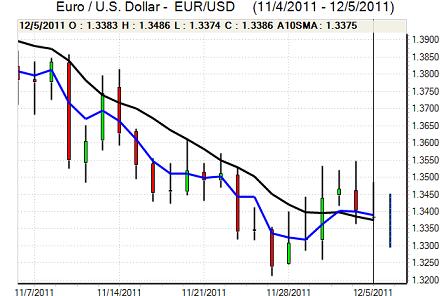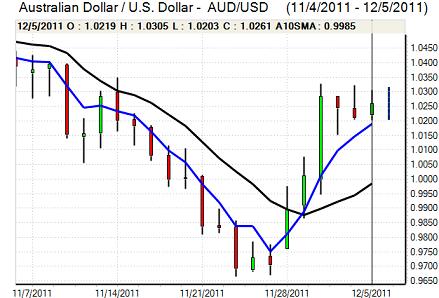EUR/USD
The Euro consolidated above 1.34 against the dollar on Monday and pushed higher during the European session with a peak above 1.3480. The Euro-zone data was broadly in line with expectations with a fifth successive decline in the EU Sentix index while there was a small downward revision to the services-sector PMI index. There was a significant decline in peripheral European bond yields after the Italian austerity package was approved.
German Chancellor Merkel and French President Sarkozy met to discuss the Euro-zone crisis in Paris. They called for revisions to the Lisbon Treaty with much tougher restrictions on the budget and automatic sanctions levies against countries breaching deficit limits. The leaders were looking to put a new Treaty in place by March.
There was, however, an important concession with Merkel stating that private investors would not be forced to accept losses in the event of a default or bailout. There was some initial relief that the governments had managed to reach a joint position which boosted the Euro, although it was unable to sustain gains.
Ratings agency Standard & Poor’s stated that there were important risks to European credit ratings All AAA country ratings would be subjected to review with the clear risk of downgrades, especially for France. There were also expectations that the ECB would take a more dovish tone at Thursday’s meeting which sapped currency support.
The US ISM services-sector index was weaker than expected with a decline to 52.0 for November from 52.9 previously. Orders gained slightly for the month, but there was an unexpected retreat in the employment index back to below the 50 level. The data overall served to dampen optimism surrounding the US economy.
The US impact was measured as Euro-zone developments remained dominant and the Euro weakened to lows around 1.3360 late in the US session.

Source: VantagePoint Intermarket Analysis Software
Call now and you will be provided with FREE recent forecasts
that are up to 86% accurate* 800-732-5407
If you would rather have the recent forecasts sent to you, please go here
Yen
The dollar was unable to make any fresh impression on resistance in the 78 area against the yen on Monday and retreated to lows near 77.70 as ranges remained generally narrow. The US currency was unable to gain any support from the US economic data.
Underlying risk appetite was also fragile following the ratings warnings by Standard & Poor’s and markets were also uneasy over the Chinese outlook following an increase in media speculation surrounding a hard landing. In this environment, there was still a clear reluctance to sell the yen aggressively as the Euro surrendered initial gains on the crosses.
Sterling
Sterling found support below 1.56 against the dollar on Monday and pushed sharply higher during the European session with a peak above 1.57.
There was some initial relief following the latest PMI services-sector report with the index edging high to 52.1 for November from 51.3 previously. There was still an important mood of caution surrounding the economy and managers were certainly not optimistic, but relief that the index had not dipped to below the pivotal 50 level which will ease immediate pressure for additional Bank of England action.
The latest BRC retail sales report was weaker than expected with a 1.6% annual decline the weakest reading for six months. There were further concerns surrounding the retail spending outlook as incomes remained under strong pressure.
There was still some evidence of defensive support for the UK currency and credit-rating warnings for Euro-zone members would provide important initial Sterling support. The backing could prove to be short-lived give the risk that the UK rating will also come under serious threat.
Sterling retreated back towards 1.56 against the dollar on a wider US move, but did strengthen to near 0.8550 against the Euro.
Swiss franc
The dollar found support near 0.9160 against the franc on Monday and pushed to highs near 0.9240 during the Asian session on Tuesday. The Swiss currency was hampered by fresh selling pressure on the crosses as the Euro briefly pushed to challenge the 1.24 area. There was a potential reduction in safe-haven franc demand as peripheral Euro-zone bond yields fell.
Official policies continued to have an extremely important market impact and there was fresh speculation that the National Bank would look to shift the minimum Euro level to at least 1.30 from 1.20 now.

Source: VantagePoint Intermarket Analysis Software
Call now and you will be provided with FREE recent forecasts
that are up to 86% accurate* 800-732-5407
If you would rather have the recent forecasts sent to you, please go here
Australian dollar
The Australian dollar maintained a firm tone on Monday and peaked at the 1.03 level as risk appetite remained firm and the US currency was generally on the defensive. The Australian dollar was unable to sustain the gains and weakened back to the 1.0240 area as Wall Street gains were pared back.
The Reserve Bank of Australia cut interest rates for the second successive month with another 0.25% reduction to 4.25%. Bank Governor Stevens warned over tighter financing conditions and the probability of weaker growth, especially in view of the European sovereign-debt crisis. Market expectations were divided and the Australian dollar retreated to test support below 1.02.



